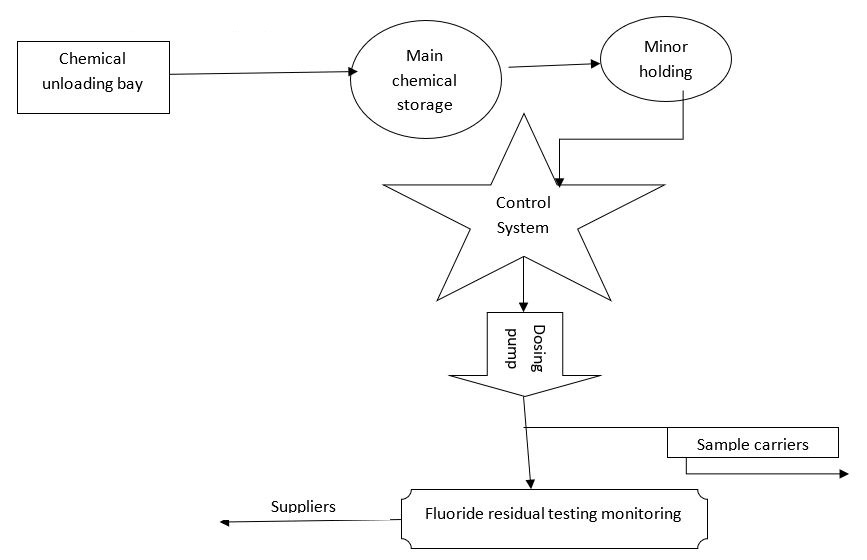For Davis Water Suppliers to meet the requirements of the Water Regulatory Bodies, they need to install Water Fluoridating Systems. Accordingly, the Water Fluoridating Plant design is to help them meet the requirement of the laws regulating water suppliers at an efficient cost. Additionally, the system meets the minimum requirements of fluoride chemical prescription under section 4 of the Water Fluoridation Regulation. That is, it can use any of the chemicals suitable for fluoridating water including Sodium fluorosilicate, Fluorosilicic acid, and sodium fluoride. Whereby, the system does not allow the amount of fluoride to exceed 1.5mg/l.
There are various roles that the system is expected to play. For instance, it must have an instrument measuring the immediate fluoride levels in the water, calculate the real-time water flow rates, fluoride dose rate, and analyze fluoride concentration. Additionally, it must have both manual and automatic shut down available at all times for closing the dosing in cases of emergency (Queensland Government 4).
To meet the high regulations demanded, the system operations designs are fully automated, the dosing equipment interlocks and it has a flow meter to measure the rate of water flows. The fact that the system interlocks, allows the dosing system to lock itself in case one part of the system fails. On the other hand, the flow meter provides the rates of water flow to the dosing facility, which interprets the amount of fluoride needed in the water. It is from the flow rates, the dosing facility releases fluoride. In case the flow meter malfunctions, the system interlocks and prevents the release of wrong volumes of fluoride.
Another thing helping to feed the dosing facility with water flow information is the flow switch. When the flow switch is off, the dosing system will never release fluoride. Hence, the dosing facility releases fluoride when it detects the flow switch is on. However, there occurs inconsistency between the flow switch and flow meter. As a result, the control system is available to ensure the dosing facility switches off when these differences occur. Nevertheless, the whole system may fail in its regulations and as a result, there is an alarm system to notify persons attending them when the fluoride levels exceed 1.3ml/l.
Similarly, the tanks holding chemicals such as sodium fluoride and fluorosilicic acid have online level indicators monitoring them and the graduated scale is readable at ease. Consequently, the tanks refill before being exhausted.
Operational Feature
Fluorosilicic acid is unloaded at an unloading bay where spills are contained easily and pumped using 3-phase power pumps into fluorosilicic storage tanks. Each fluorosilicic tank for every borehole holds 10, 000 liters, and radar installation help to prevent spills. Then, from the fluorosilicic tank, another pump transfers the chemicals slowly to the second tank with lower capacity but fills automatically. Load cells monitor the second tank to maintain the recommended volume. Additionally, the pump feeding the second tank is fitted with an alarm and safety pipe to deliver chemicals back to the first tank in times of malfunctions (Maffescioni 17).
From there, the chemical passes through the control room. In the control room, it provides access points for starting or stopping all automated operations. It can also stop any flow of chemical and already treated water. Then, the pipe supplying chemicals reaches the dosing pumps where water is treated. After the water is treated, a sample of water is taken to the online analyzer positioned in the laboratory, and the remaining water is checked through a local control system, which is fitted with a checking alarm. The alarm makes a notification when there is a persistent 1.3ml/g level of fluoride (Maffescioni 18).

In conclusion, from the above, the below diagram illustrates the operational feature of the fluoridation system to be used when adding fluoride to each wells water serving Davis company.
References
Queensland Government. Queensland Health-Population Health Queensland Investigators Report. Water Fluoridation Incident-North Pipe Water Treatment Plant. 2009.Web.
Rick, Maffescioni. Fluoride Dosing Facility-WoDonga WTP: Design and Construction Challenges-Safety Operation. 70 Annual Water Industry Engineers and Operators Conference, Bendigo Exhibition Center. 2007. Web.